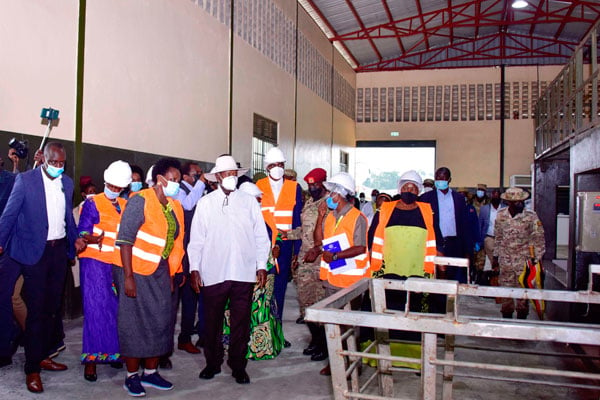Prime
Museveni rallies local industrial initiatives as Luweero leather tannery takes shape

President Museveni inspecting Kawumu leather tannery on October 7, 2022. PHOTO/ PPU
What you need to know:
- The Kawumu leather tannery where the government has injected Shs12 billion for the first phase currently employs 90 people, the State House Comptroller, Ms Jane Barekye revealed. Government will ensure additional Shs12 billion for the second phase that will be rolled out after the successful roll out of the first phase.
President Museveni has re-echoed the need for Ugandan industrialists to acknowledge the value chain potential for locally produced material such as the hides and skins under the value chain system for the local and export market.
Mr Museveni while commissioning the Kawumu Tannery Uganda located at Kawumu Village in Luweero District revealed that Uganda is among the top four exporters of hides and skins in Africa but barely earns $50 million from the highly prized transaction.
“Leather is imported, paper is imported and we do so for many other products. For many years, I have been fighting a war against some of the goods imported yet we have the capacity to add to our own goods to compete for international and home markets,” he said.
According to the president, Uganda is now able to produce milk, soda, beer among other items that also go for the export Market.
“I will soon start a war on imported paper. The problem with importation is that those products are costly. After adding value to hides and skins they get from us, the Italians will export leather at a higher price. We also give out our employment opportunities through importation. Now that we are done with leather importation, our next war is on paper,” he said.
The Kawumu leather tannery where the government has injected Shs12 billion for the first phase currently employs 90 people, the State House Comptroller, Ms Jane Barekye revealed. Government will ensure additional Shs12 billion for the second phase that will be rolled out after the successful roll out of the first phase.
“We have procured all the machines for phase II of the leather factory and have the land. What we don’t have are the buildings to start the shoe factory in line with our programme for phase II,” she told the President.
The leather tannery now produces 10 tons of leather per day while the maiden strategy is to ensure that over 1,000 people get jobs when the two factories get operationalized, the President was told.
The leather tannery gets its raw materials from the greater Luweero locality, Mbarara among other areas. A kilogram of hides now fetches Shs2,100 up from the Shs2,000, the normal market price for the hides and skins in many parts of Uganda.
Minister of State for Trade, Industry and Cooperatives, Mr David Bahati explained that the factory is an import substitution and a big breakthrough for Uganda’s industrialization journey.
"This factory is an important step in solving the problem of leather, especially for the small scale enterprises that have been suffering to import it. We want to thank you, Your Excellency, for your visionary leadership and we want to thank the State House comptroller for executing the project,” he said.





